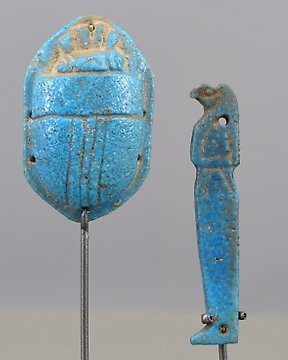
Égypte ancienne, période tardive Faience Un Scarabée du Cœur et deux des Fils d'Horus - 6.9 cm
Nº 77879863

Nº 77879863

Description
RARE and TINY Scaraboide en forme de canard retroussé au cou ajouré, 1353-1322 BC Amarna Period -
- exceptional color !
On the bottom the Hieroglyphs Maat and Nefer are to be read,
Nefer Maat could have been a name, but more probably it speaks about the divine order and the beauty of order in the Universe: maat= divine order, nefer= beauty or also "good" "right"
In ancient Egyptian art and symbolism, the duck held various meanings and associations depending on the context and the specific type of duck depicted. Ducks were a common subject in Egyptian art, and their symbolism was often linked to their behavior, habitat, and cultural significance. Here are some key aspects of the symbolism of ducks in ancient Egyptian art:
Fertility and Regeneration: Ducks were frequently associated with fertility and regeneration. This connection arose from the observation that ducks often lay numerous eggs and inhabit wetlands, which were places of abundance and fertility in the Egyptian landscape. Depictions of ducks could symbolize the idea of renewal, growth, and the cycle of life.
Inundation and Water: Ducks were waterfowl, and their presence in Egyptian art was often linked to the importance of water in Egyptian life, particularly the annual inundation of the Nile River. The Nile's flooding was essential for agriculture and the rejuvenation of the land. Ducks represented the connection between water, fertility, and the sustenance of the Egyptian people.
Associations with Goddesses: Some goddesses in the Egyptian pantheon, such as Hathor and Isis, were occasionally depicted with the head of a duck or associated with duck symbolism. These goddesses were often linked to maternal aspects, childbirth, and nurturing. Ducks, as waterfowl, were seen as protective and nurturing symbols in this context.
Symbol of Transition: Ducks, like other waterfowl, were considered creatures that moved between the realms of land and water. This made them symbolic of transitions and transformations, including the passage from life to the afterlife. Ducks were sometimes included in funerary art and rituals to assist the deceased in their journey to the afterlife.
Hunting and Sport: In some contexts, ducks were depicted in scenes related to hunting and sport. The successful hunting of ducks might symbolize prowess, skill, and abundance. Hunting scenes featuring ducks were common in tomb decorations and were meant to convey the idea of a prosperous afterlife for the deceased.
Artistic Representation: Ducks, with their distinctive and elegant shapes, were often included in Egyptian art for their aesthetic appeal. They added naturalistic elements to scenes, providing a sense of balance and harmony in the artwork.
It's important to note that the symbolism of ducks in ancient Egyptian art was not fixed and could vary depending on the specific context, time period, and regional traditions. Ducks were one of many elements in Egyptian iconography that contributed to the rich tapestry of symbolism in this ancient civilization, reflecting their deep connection to the natural world and their beliefs about the cyclical nature of life and death.
périod
new kingdom. 1353-1322 BC Amarna Period
reference bibliographique
Andrews, C., Amulets of Ancient Egypt, n°54d
Provenance
Collection d’un ancien égyptophile acquis entre 1910 et 1925, ensuite par succession
vidéo link
https://www.dropbox.com/scl/fo/p65o5si0e14ad5fdqg6pu/h?rlkey=5dzlhb4wiffeur49voxucqd3l&dl=0
Comment acheter sur Catawiki ?
1. Découvrez des objets d’exception
2. Faites la meilleure offre
3. Effectuez un paiement sécurisé